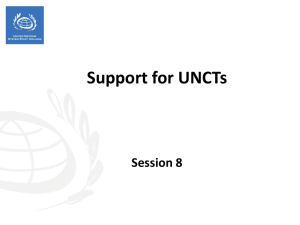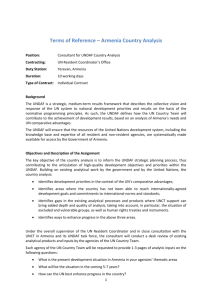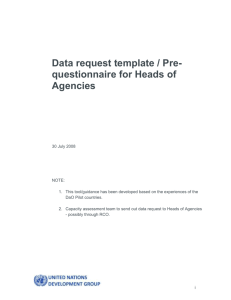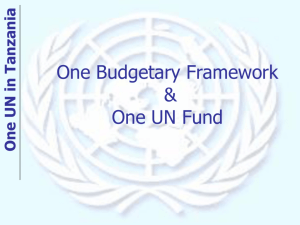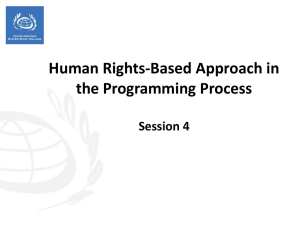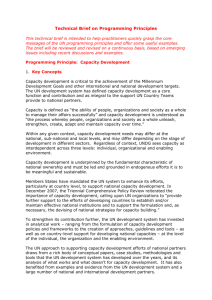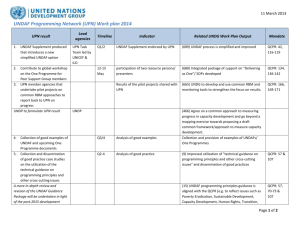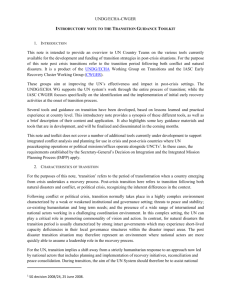Useful Tips for Roadmap Preparation
advertisement
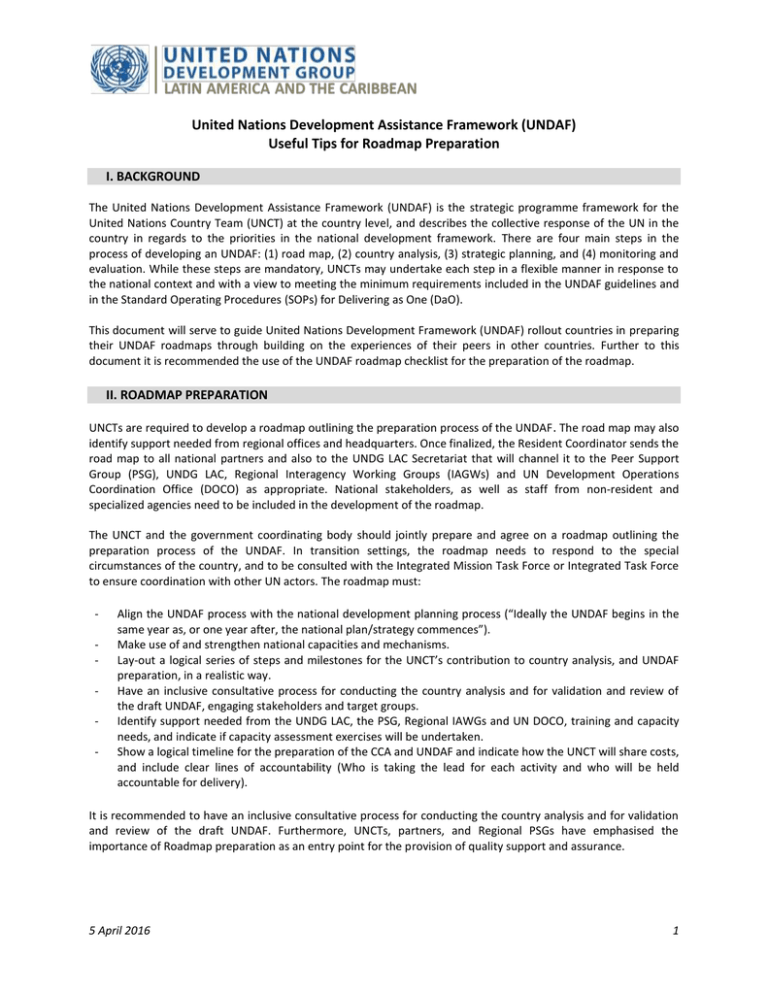
United Nations Development Assistance Framework (UNDAF) Useful Tips for Roadmap Preparation I. BACKGROUND The United Nations Development Assistance Framework (UNDAF) is the strategic programme framework for the United Nations Country Team (UNCT) at the country level, and describes the collective response of the UN in the country in regards to the priorities in the national development framework. There are four main steps in the process of developing an UNDAF: (1) road map, (2) country analysis, (3) strategic planning, and (4) monitoring and evaluation. While these steps are mandatory, UNCTs may undertake each step in a flexible manner in response to the national context and with a view to meeting the minimum requirements included in the UNDAF guidelines and in the Standard Operating Procedures (SOPs) for Delivering as One (DaO). This document will serve to guide United Nations Development Framework (UNDAF) rollout countries in preparing their UNDAF roadmaps through building on the experiences of their peers in other countries. Further to this document it is recommended the use of the UNDAF roadmap checklist for the preparation of the roadmap. II. ROADMAP PREPARATION UNCTs are required to develop a roadmap outlining the preparation process of the UNDAF . The road map may also identify support needed from regional offices and headquarters. Once finalized, the Resident Coordinator sends the road map to all national partners and also to the UNDG LAC Secretariat that will channel it to the Peer Support Group (PSG), UNDG LAC, Regional Interagency Working Groups (IAGWs) and UN Development Operations Coordination Office (DOCO) as appropriate. National stakeholders, as well as staff from non-resident and specialized agencies need to be included in the development of the roadmap. The UNCT and the government coordinating body should jointly prepare and agree on a roadmap outlining the preparation process of the UNDAF. In transition settings, the roadmap needs to respond to the special circumstances of the country, and to be consulted with the Integrated Mission Task Force or Integrated Task Force to ensure coordination with other UN actors. The roadmap must: - Align the UNDAF process with the national development planning process (“Ideally the UNDAF begins in the same year as, or one year after, the national plan/strategy commences”). Make use of and strengthen national capacities and mechanisms. Lay-out a logical series of steps and milestones for the UNCT’s contribution to country analysis, and UNDAF preparation, in a realistic way. Have an inclusive consultative process for conducting the country analysis and for validation and review of the draft UNDAF, engaging stakeholders and target groups. Identify support needed from the UNDG LAC, the PSG, Regional IAWGs and UN DOCO, training and capacity needs, and indicate if capacity assessment exercises will be undertaken. Show a logical timeline for the preparation of the CCA and UNDAF and indicate how the UNCT will share costs, and include clear lines of accountability (Who is taking the lead for each activity and who will be held accountable for delivery). It is recommended to have an inclusive consultative process for conducting the country analysis and for validation and review of the draft UNDAF. Furthermore, UNCTs, partners, and Regional PSGs have emphasised the importance of Roadmap preparation as an entry point for the provision of quality support and assurance. 5 April 2016 1 Early, consistent engagement often makes a difference in terms of improving engagement with stakeholders like NRAs and specialised agencies, encouraging government ownership of the UNDAF process, identifying capacity needs of the UNCT, and sharpening the overall approach for country analysis and UNDAF preparation. Finally, it is recommended that the UNDAF commence in the same year as or one year after the national development strategy. If not, if possible, the UNCT could outline a strategy to align the UNDAF cycle in the medium term. Make use of and strengthen national capacities and mechanisms. The roadmap should also include trainings required, for example, on the UN programming principles, before the country analysis starts. It should also consider that building consensus and having an inclusive process, is time demanding, so it should include realistic deadlines. III. RECOMMENDED PARTS Based on the above-mentioned, it is recommended that the following sections should be included in the UNDAF roadmap. The Roadmap document should be no longer than 5 pages. Please note the methodology and content should be adapted to each country context and needs. 1. Background. Describes briefly the context of the UNCT and relevant background information on previous UNDAF processes. 2. Purpose and Process. The section should include information on the proposed mechanism to coordinate the process, and lay-out lines of accountability specifying who is taking the lead for each step of the process and who will be held accountable for delivery. 2.1. Alignment with key National Development Challenges Among others, it is recommended to make a review on the alignment of the future UNDAF with national development planning processes and content (example, national development plan; poverty reduction strategy). 2.2. UNDAF Preparation. In this section, the UNCT should reflect on the discussion and agreements regarding the implementation of the One Programme and other pillars of the SOPs for DaO. As per the SOPs, UNDAFs should be strategic (at the outcome level) and include a legal annex that substitutes the Agencies Country Programme Action Plans. UNCTs are expected to develop annual/biennial joint work plans led by Results Groups and should establish a Joint National/ UN Steering Committee. The roadmap should also include information regarding the ways the UNCT plans to incorporate the SOPs in the UNDAF design process (i.e. engagement and alignment between the UNDAF and the Business Operations Strategy). This section should also reflect on (i) how the UNCT will use the UNDAF preparation process as a means for supporting Government to localize the SDGs and monitor their implementations and (ii) should include the plan to use the recommendations of the Universal Periodic Review, Treaty Bodies and other UN HR mechanisms for CCA/UNDAF preparation. 5 April 2016 2 2.3. Stakeholder engagement. It is recommended to include relevant information on how stakeholders1 have been involved in the development of the Roadmap, to ensure that stakeholders have a solid understanding of the UNDAF process, and how and when will they be involved throughout the whole UNDAF development process. Furthermore, it is relevant to draw, as appropriate, on existing joint or collaborative UN frameworks and strategic partnerships which can support country level action and increase coherence in the UNDAF (example, the Education for All global action plan, ILO Decent Work Country Programme, existing Memoranda of Understanding signed by agencies, strategic assessments or integrated planning processes). Looking forward, the roadmap should reflect how consultative processes in the Roadmap will include stakeholders, and is there planned engagement with marginalized, and excluded groups. 2.4. Analysis and lessons learned on UNDAF formulation. This section should incorporate relevant information from the current cycle that could be used to formulate the next UNDAF and increase the quality of the document, i.e. UNDAF reviews and evaluations, lessons learned, etc. 3. Support Required. It is very important to make an effort in this phase of the process to identify what specific support the UNCT needs from (1) UNDG LAC (2) PSG (3) Regional IAWGs and (4) UNDOCO. The roadmap should include indicative dates for the PSG review of draft documents. 4. Annexes. A UNDAF Roadmap Timeline, indicating costs, lines of accountability and milestones for UNDAF formulation, should be included in the document (see example below). It is recommendable that the Roadmap document presents a logical series of steps, milestones, and a timeline for the UNCT`s contribution to county analysis and for UNDAF preparation also it will show how the UNCT will share costs. The table should lay-out the steps and milestones for the UNCT’s contribution to country analysis, and UNDAF preparation. Also it should include indicate dates for workshops (e.g. HRBA-RBM, SPR) and skills trainings, dates for the PSG review of documents, information regarding the Strategic Planning Retreat expected days, etc. Activities Budget Lead UNDAF Roadmap Timeline 2016 Jun Jul May 7 14 21 28 7 14 21 28 7 14 21 Aug 28 7 14 21 Sept 28 7 14 21 … 28 1 In the UNDAF Guidelines, ‘stakeholders’ refer to governments, including line ministries; social partners, including workers and employers organizations; other development partners relevant to a country context; civil society; and NGOs. 5 April 2016 3
